Developing a GIS-Based Decision Rule for Sustainable Marine Aquaculture Site Selection: An Application of the Ordered Weighted Average Procedure
Abstract
1. Introduction
2. Materials and Methods
2.1. Case Study Specification
2.2. Identification, Obtaining, and Preparing the Environmental Criteria and Spatial Database Acquisition
2.2.1. Water Quality Parameters: Sea Surface Temperature
2.2.2. Water Quality Parameter: Suspended Solids
2.2.3. Water Quality Parameter: Chlorophyll-a
2.2.4. Physical–Environmental Parameter: Bathymetry
2.2.5. Physical–Environmental Parameter: Slope of Seabed
2.2.6. Physical–Environmental Parameter: Maximum Wave Height and Wind Speed
2.2.7. Physical–Environmental Parameter: Current Velocity
2.2.8. Social–Economic Parameters
2.3. Standardization and Priority Weighting of Criteria
2.4. GIS-Based Multi-Criteria Evaluation (MCE) with Ordered Weighted Averaging (OWA) Method
2.5. Site Selection
2.6. Comparison of OWA Model’s Results with Existing Sites (ROC)
2.7. Sensitivity Analysis
3. Results
3.1. Standardization and Priority Weighting of Criteria
3.2. GIS-Based Multi-Criteria Evaluation (MCE) with Ordered Weighted Averaging (OWA) Technique
3.3. Site Selection
3.4. Comparison of OWA Model’s Results with Existing Sites (ROC)
3.5. Results of Sensitivity Analysis
4. Discussion
Evaluating and Comparing the Existing Aquaculture Farms and Selected Sites in the Area of Study
5. Conclusions
Author Contributions
Funding
Institutional Review Board Statement
Informed Consent Statement
Data Availability Statement
Acknowledgments
Conflicts of Interest
References
- Asche, F. Farming the sea. Mar. Resour. Econ. 2008, 23, 527–547. [Google Scholar] [CrossRef]
- Lucas, J.S.; Southgate, P.C. Reproduction, Life Cycles and Growth. Aquaculture: Farming Aquatic Animals and Plants; John Wiley & Sons: Hoboken, NJ, USA, 2019; pp. 113–126. ISBN 978-1-119-23086-1. [Google Scholar]
- Godfray, H.C.J.; Beddington, J.R.; Crute, I.R.; Haddad, L.; Lawrence, D.; Muir, J.F.; Toulmin, C. Food security: The challenge of feeding 9 billion people. Science 2010, 327, 812–818. [Google Scholar] [CrossRef] [PubMed]
- FAO. Food and Agriculture Organization of the United Nations. The State of World Fisheries and Aquaculture; FAO: Rome, Italy, 2014; p. 223. Available online: http://www.fao.org/3/a-i3720e.pdf (accessed on 30 September 2015).
- FAO. Food and Agriculture Organization of the United Nations. The State of World Fisheries and Aquaculture; FAO: Rome, Italy, 2020; p. 224. Available online: http://www.fao.org/3/ca9229en/ca9229en.pdf (accessed on 30 August 2020).
- Christie, N.; Smyth, K.; Barnes, R.; Elliott, M. Co-location of activities and designations: A means of solving or creating problems in marine spatial planning? Mar. Policy 2014, 43, 254–261. [Google Scholar] [CrossRef]
- Afroz, T.; Alam, S. Sustainable shrimp farming in Bangladesh: A quest for an Integrated Coastal Zone Management. Ocean Coast. Manag. 2013, 71, 275–283. [Google Scholar] [CrossRef]
- Suplicy, F.M.; Vianna, L.F.D.N.; Rupp, G.S.; Novaes, A.L.; Garbossa, L.H.; de Souza, R.V.; dos Santos, A.A. Planning and management for sustainable coastal aquaculture development in Santa Catarina State, south Brazil. Rev. Aquac. 2017, 9, 107–124. [Google Scholar] [CrossRef]
- Pérez, O.M.; Ross, L.G.; Telfer, T.C.; del Campo Barquin, L.M. Water quality requirements for marine fish cage site selection in Tenerife (Canary Islands): Predictive modelling and analysis using GIS. Aquaculture 2003, 224, 51–68. [Google Scholar] [CrossRef]
- Cho, Y.; Lee, W.C.; Hong, S.; Kim, H.C.; Kim, J.B. GIS-based suitable site selection using habitat suitability index for oyster farms in Geoje-Hansan Bay, Korea. Ocean Coast. Manag. 2012, 56, 10–16. [Google Scholar] [CrossRef]
- Llorente, I.; Luna, L. The competitive advantages arising from different environmental conditions in seabream, Sparus aurata, production in the Mediterranean Sea. J. World Aquac. Soc. 2013, 44, 611–627. [Google Scholar] [CrossRef]
- Tammi, I.; Kalliola, R. Spatial MCDA in marine planning: Experiences from the Mediterranean and Baltic Seas. Mar. Policy 2014, 48, 73–83. [Google Scholar] [CrossRef]
- Perez, O.M.; Telfer, T.C.; Ross, L.G. Geographical information systems-based models for offshore floating marine fish cage aquaculture site selection in Tenerife, Canary Islands. Aquac. Res. 2005, 36, 946–961. [Google Scholar] [CrossRef]
- Corner, R.A.; Brooker, A.J.; Telfer, T.C.; Ross, L.G. A fully integrated GIS-based model of particulate waste distribution from marine fish-cage sites. Aquaculture 2006, 258, 299–311. [Google Scholar] [CrossRef]
- Longdill, P.C.; Healy, T.R.; Black, K.P. An integrated GIS approach for sustainable aquaculture management area site selection. Ocean Coast. Manag. 2008, 51, 612–624. [Google Scholar] [CrossRef]
- Radiarta, I.N.; Saitoh, S.I. Satellite-derived measurements of spatial and temporal chlorophyll-a variability in Funka Bay, southwestern Hokkaido, Japan. Estuar. Coast. Shelf Sci. 2008, 79, 400–408. [Google Scholar] [CrossRef]
- Kamruzzaman, M.; Baker, D. Will the application of spatial multi criteria evaluation technique enhance the quality of decision-making to resolve boundary conflicts in the Philippines? Land Use Policy 2013, 34, 11–26. [Google Scholar] [CrossRef]
- Krois, J.; Schulte, A. GIS-based multi-criteria evaluation to identify potential sites for soil and water conservation techniques in the Ronquillo watershed, northern Peru. Appl. Geogr. 2014, 51, 131–142. [Google Scholar] [CrossRef]
- Nayak, A.K.; Pant, D. GIS-based aquaculture site suitability study using multi-criteria evaluation approach. Indian J. Fish. 2014, 61, 108–112. [Google Scholar]
- Nath, S.S.; Bolte, J.P.; Ross, L.G.; Aguilar-Manjarrez, J. Applications of geographical information systems (GIS) for spatial decision support in aquaculture. Aquac. Eng. 2000, 23, 233–278. [Google Scholar] [CrossRef]
- Ross, L.G.; QM, E.M.; Beveridge, M.C.M. The application of geographical information systems to site selection for coastal aquaculture: An example based on salmonid cage culture. Aquaculture 1993, 112, 165–178. [Google Scholar] [CrossRef]
- Buitrago, J.; Rada, M.; Hernández, H.; Buitrago, E. A single-use site selection technique, using GIS, for aquaculture planning: Choosing locations for mangrove oyster raft culture in Margarita Island, Venezuela. Environ. Manag. 2005, 35, 544–556. [Google Scholar] [CrossRef] [PubMed]
- Liu, Y.; Saitoh, S.I.; Radiarta, I.N.; Isada, T.; Hirawake, T.; Mizuta, H.; Yasui, H. Improvement of an aquaculture site-selection model for Japanese kelp (Saccharina japonica) in southern Hokkaido, Japan: An application for the impacts of climate events. ICES J. Mar. Sci. 2013, 70, 1460–1470. [Google Scholar] [CrossRef]
- Gimpel, A.; Stelzenmüller, V.; Grote, B.; Buck, B.H.; Floeter, J.; Núñez-Riboni ITemming, A. A GIS modelling framework to evaluate marine spatial planning scenarios: Co-location of offshore wind farms and aquaculture in the German EEZ. Mar. Policy 2015, 55, 102–115. [Google Scholar] [CrossRef]
- Dapueto, G.; Massa, F.; Costa, S.; Cimoli, L.; Olivari, E.; Chiantore, M.; Povero, P. A spatial multi-criteria evaluation for site selection of offshore marine fish farm in the Ligurian Sea, Italy. Ocean Coast. Manag. 2015, 116, 64–77. [Google Scholar] [CrossRef]
- Falconer, L.; Telfer, T.C.; Ross, L.G. Investigation of a novel approach for aquaculture site selection. J. Environ. Manag. 2016, 181, 791–804. [Google Scholar] [CrossRef]
- Aladin, N.; Plotnikov, I.; The Caspian Sea. In Lake Basin Management Initiative, Thematic Paper. 2004. Available online: http://www.worldlakes.org/uploads/Caspian%20Sea%2028Jun04.pdf (accessed on 30 August 2017).
- Kostianoy, A.G.; Kosarev, A.N. The Caspian Sea Environment; Springer Science & Business Media: Berlin, Germany, 2005; Volume 5. [Google Scholar]
- Malczewski, J.; Rinner, C. Multicriteria Decision Analysis in Geographic Information Science; Springer: New York, NY, USA, 2015; p. 31. [Google Scholar]
- Nezlin, N.P.; DiGiacomo, P.M.; Stein, E.D.; Ackerman, D. Stormwater runoff plumes observed by SeaWiFS radiometer in the Southern California Bight. Remote Sens. Environ. 2005, 98, 494–510. [Google Scholar] [CrossRef]
- Radiarta, I.N.; Saitoh, S.I.; Yasui, H. Aquaculture site selection for Japanese kelp (Laminaria japonica) in southern Hokkaido, Japan, using satellite remote sensing and GIS-based models. ICES J. Mar. Sci. 2011, 68, 773–780. [Google Scholar] [CrossRef]
- Grant, J.; Bacher, C.; Ferreira, J.G.; Groom, S.; Morales, J.; Rodriguez-Benito, C.; Saitoh, S.I.; Sathyendranath, S.; Stuart, V. Remote sensing applications in marine aquaculture. Remote Sensing in Fisheries and Aquaculture, Rep. Int. Ocean Colour Coord. Group 2009, 8, 77–88. [Google Scholar]
- Falconer, L.; Hunter, D.C.; Scott, P.C.; Telfer, T.; Ross, L. Using physical environmental parameters and cage engineering design within GIS-based site suitability models for marine aquaculture. Aquac. Environ. Interact. 2013, 4, 223–237. [Google Scholar] [CrossRef]
- Kara, A.B.; Wallcraft, A.J.; Metzger, E.J.; Gunduz, M. Impacts of freshwater on the seasonal variations of surface salinity and circulation in the Caspian Sea. Cont. Shelf Res. 2010, 30, 1211–1225. [Google Scholar] [CrossRef]
- Gorsevski, P.V.; Donevska, K.R.; Mitrovski, C.D.; Frizado, J.P. Integrating multi-criteria evaluation techniques with geographic information systems for landfill site selection: A case study using ordered weighted average. Waste Manag. 2012, 32, 287–296. [Google Scholar] [CrossRef]
- Saaty, T.L. A scaling method for priorities in hierarchical structures. J. Math. Psychol. 1977, 15, 234–281. [Google Scholar] [CrossRef]
- Amiri, M.J.; Mahiny, A.S.; Hosseini, S.M.; Jalali, S.; Ezadkhasty, Z.; Karami, S. OWA analysis for ecological capability assessment in watersheds. Int. J. Environ. Res. 2013. [Google Scholar] [CrossRef]
- Kiavarz, M.; Jelokhani-Niaraki, M. Geothermal prospectivity mapping using GIS-based Ordered Weighted Averaging approach: A case study in Japan’s Akita and Iwate provinces. Geothermics 2017, 70, 295–304. [Google Scholar] [CrossRef]
- Yager, R.R. On ordered weighted averaging aggregation operators in multicriteria decisionmaking. IEEE Trans. Syst. Man Cybern. 1988, 18, 183–190. [Google Scholar] [CrossRef]
- Mahini, A.S.; Gholamalifard, M. Siting MSW landfills with a weighted linear combination methodology in a GIS environment. Int. J. Environ. Sci. Technol. 2006, 3, 435–445. [Google Scholar] [CrossRef]
- Eastman, R.J. IDRISI guid to GIS and Image processing. In Accessed in IDRISI Selva 17.00; Clark University: Worcester, MA, USA, 2012; p. 354. [Google Scholar]
- Eastman, J.R. TerrSet Manual System. In Accessed in TerrSet [18.10]; Clark University: Worcester, MA, USA, 2015; p. 392. [Google Scholar]
- KKumar, R.; Nandy, S.; Agarwal, R.; Kushwaha, S.P.S. Forest cover dynamics analysis and prediction modeling using logistic regression model. Ecol. Indic. 2014, 45, 444–455. [Google Scholar] [CrossRef]
- Butler, J.; Jia, J.; Dyer, J. Simulation techniques for the sensitivity analysis of multi-criteria decision models. Eur. J. Oper. Res. 1997, 103, 531–546. [Google Scholar] [CrossRef]
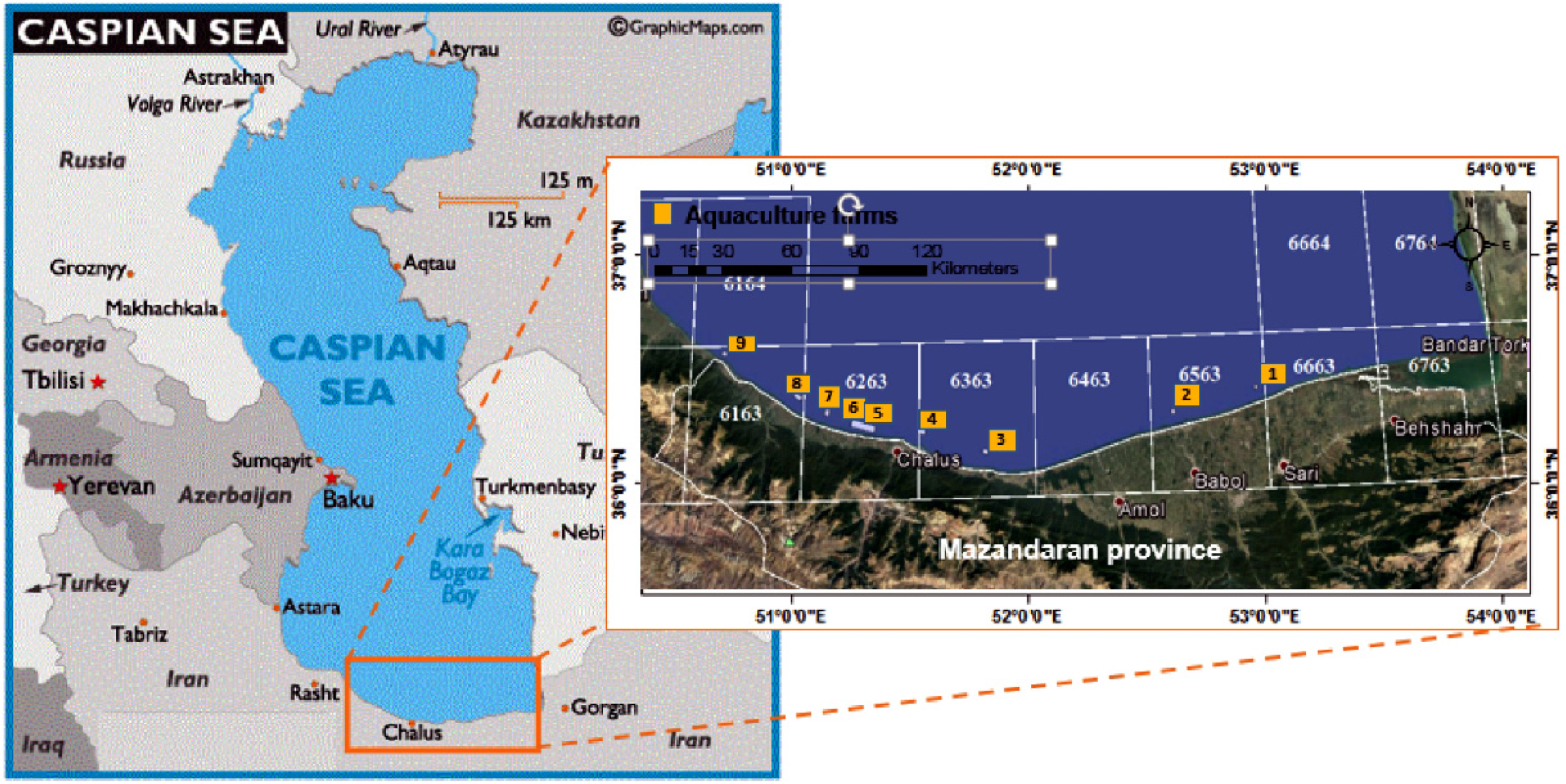
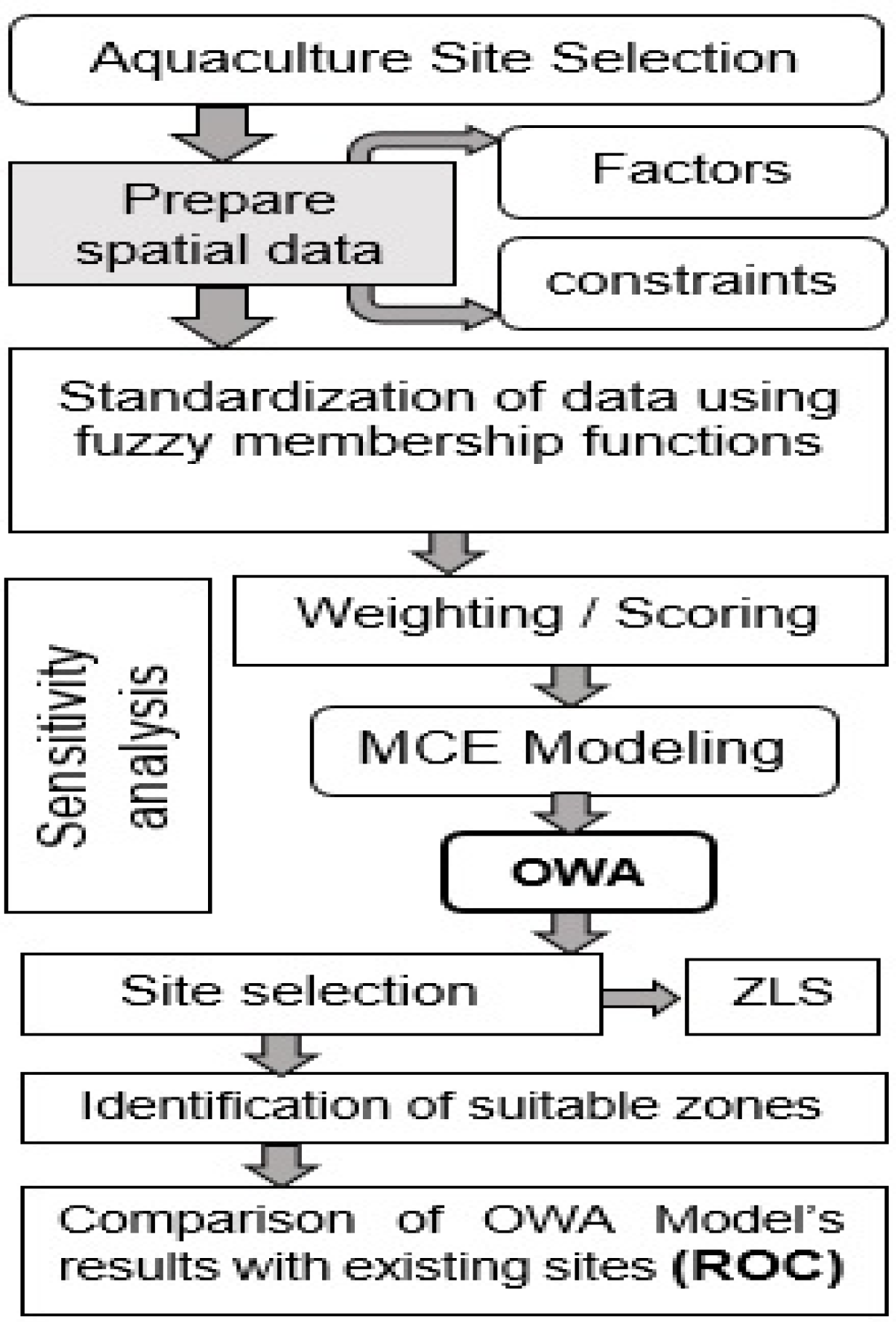


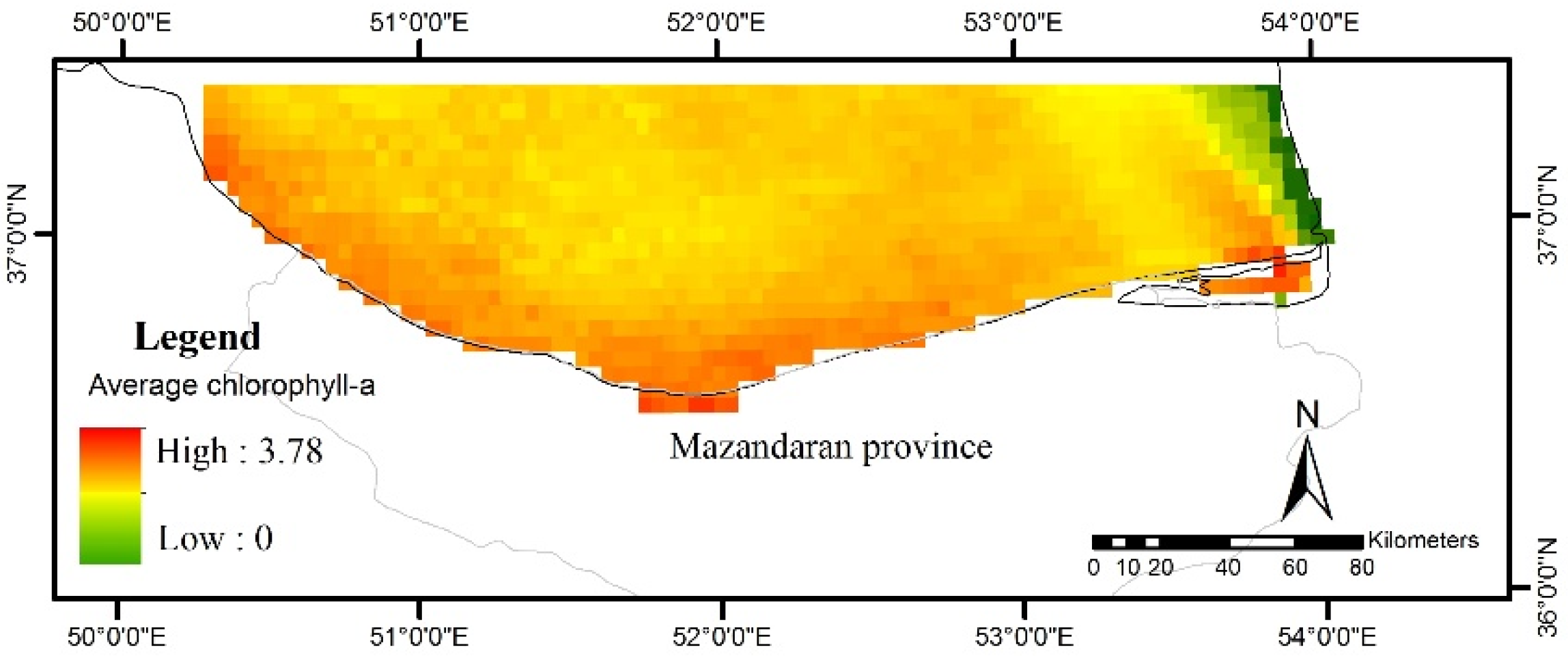

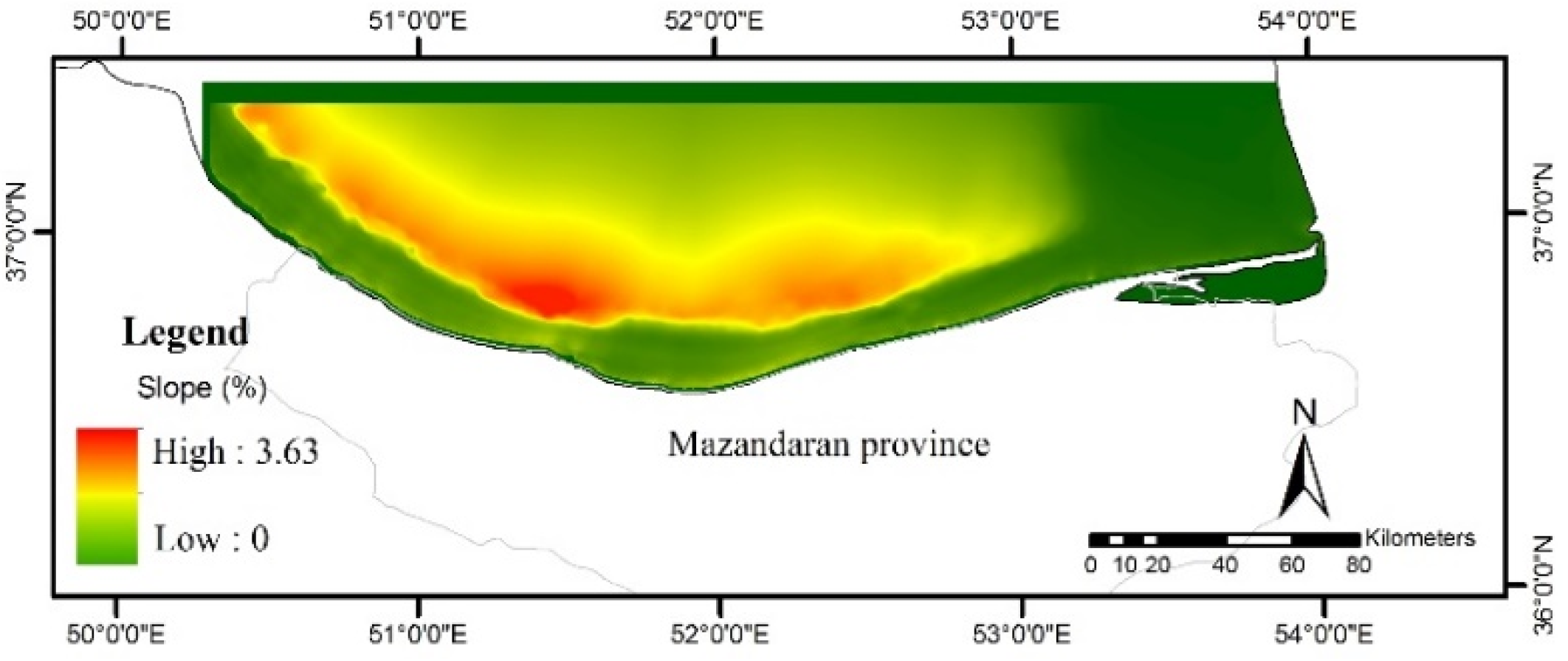


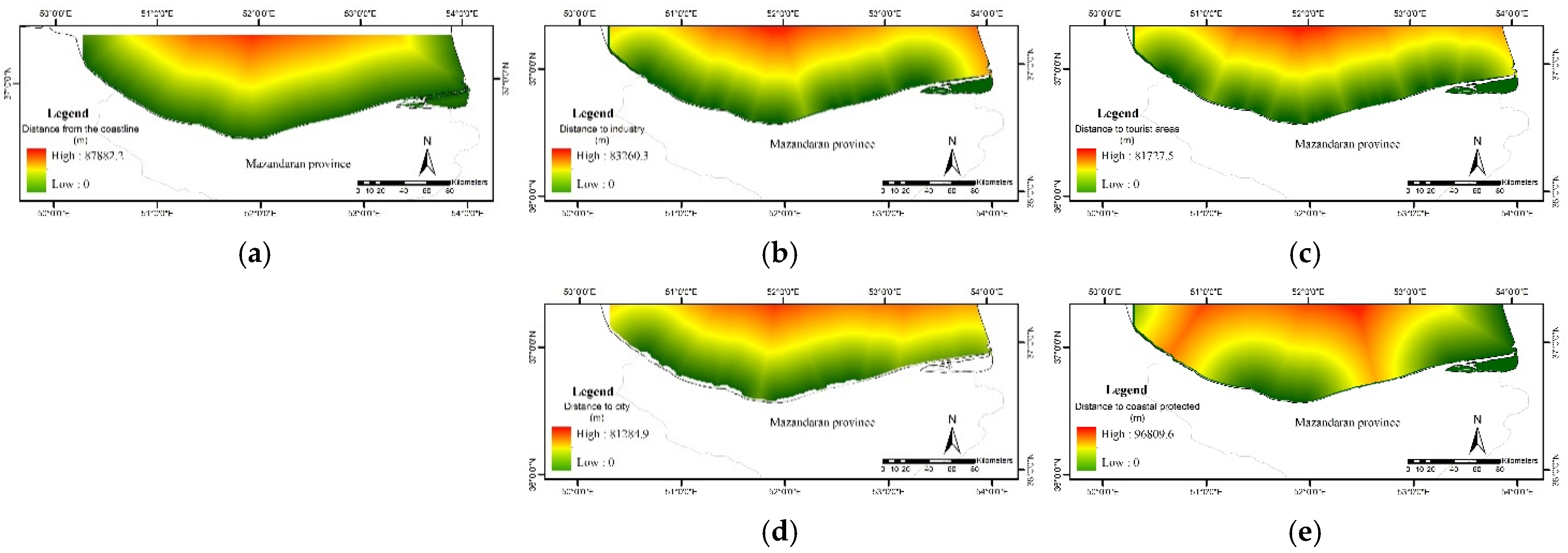
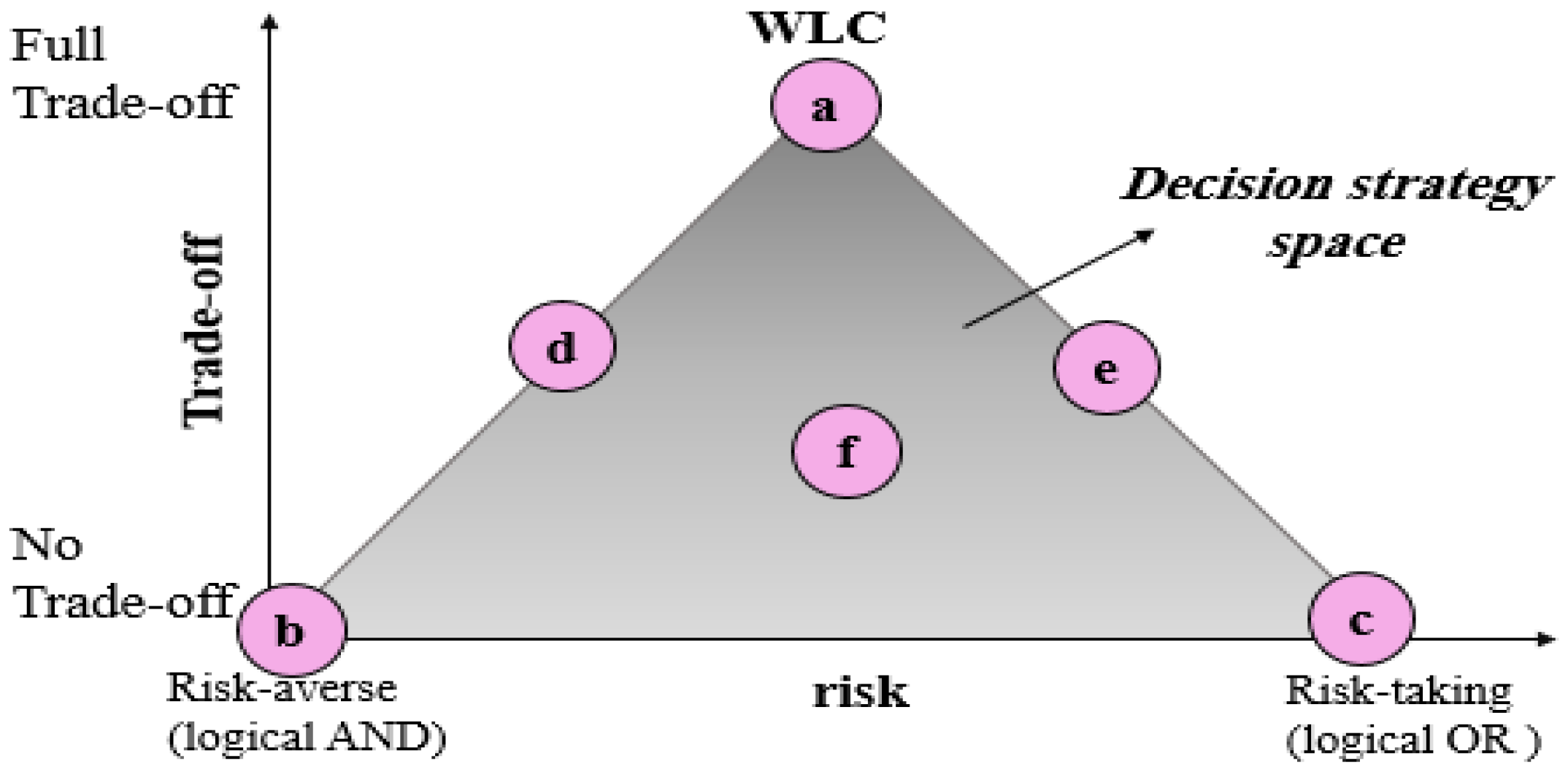

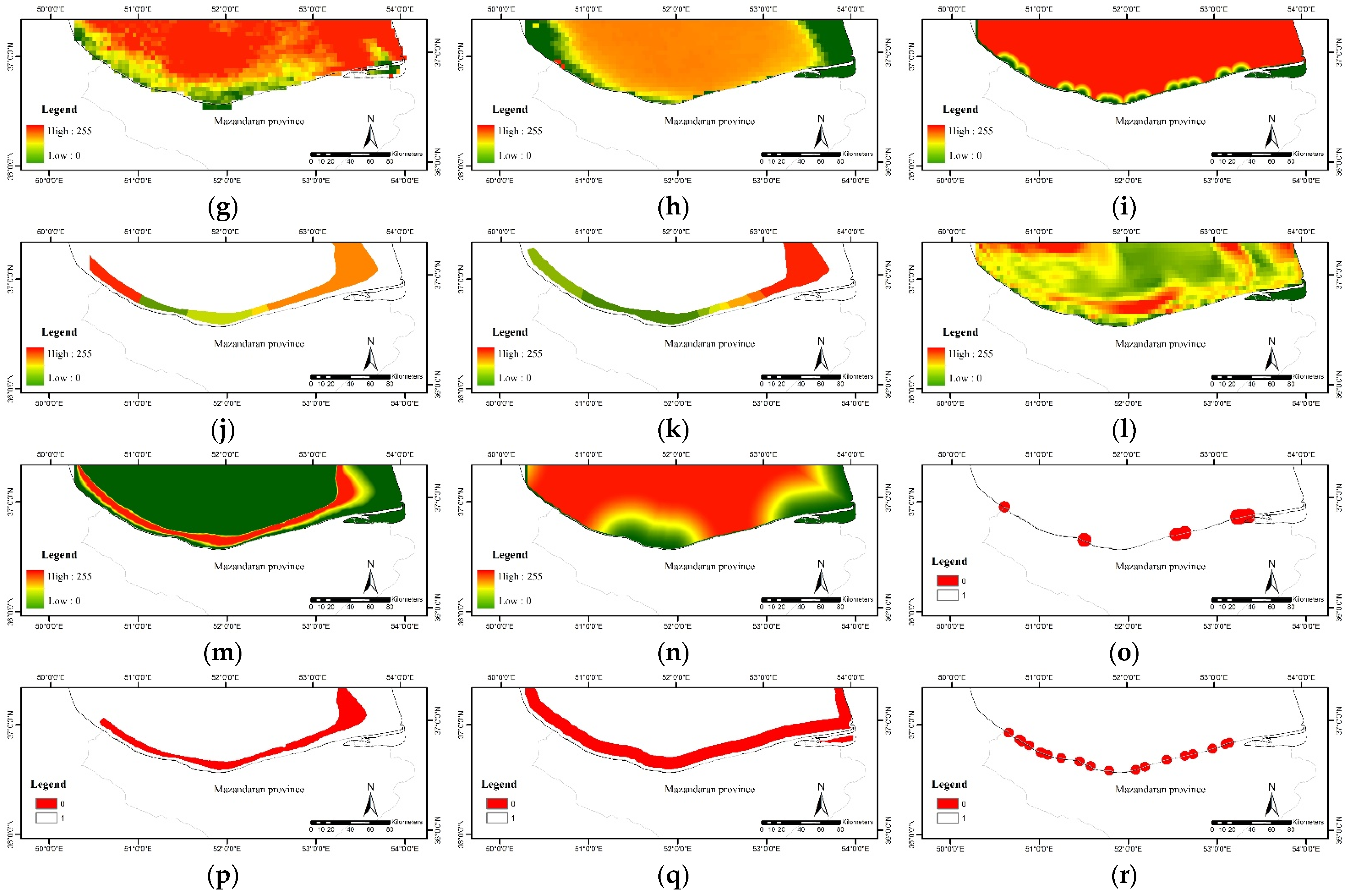
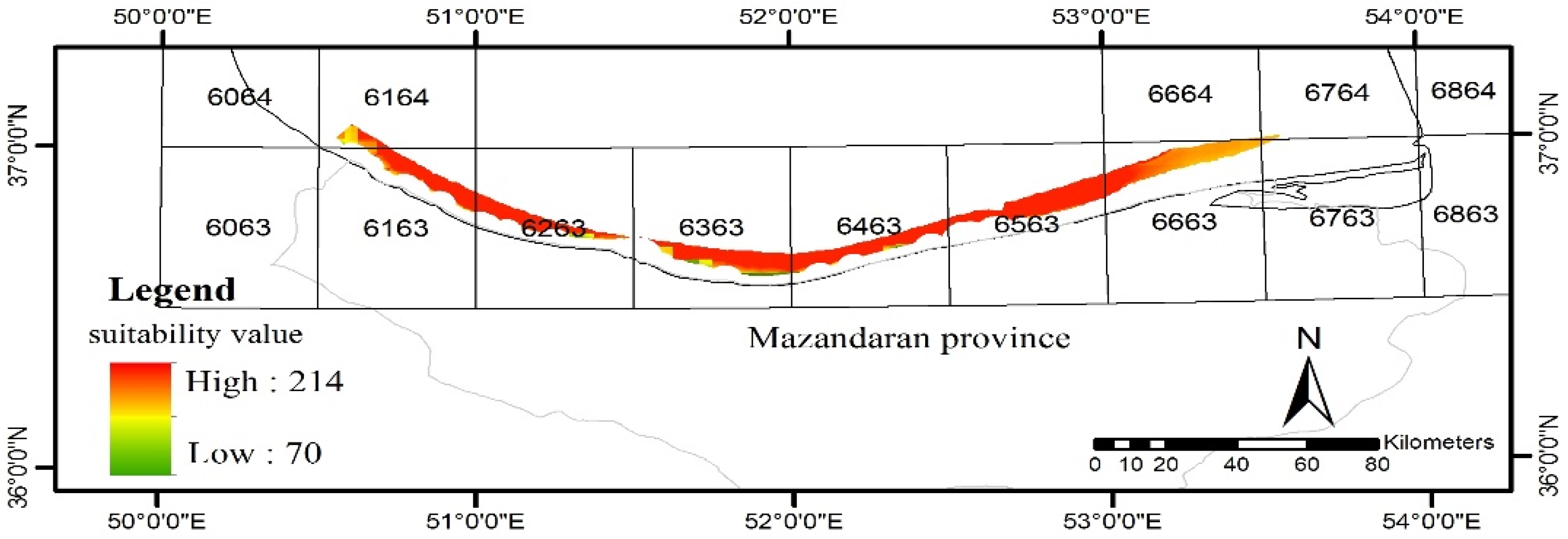

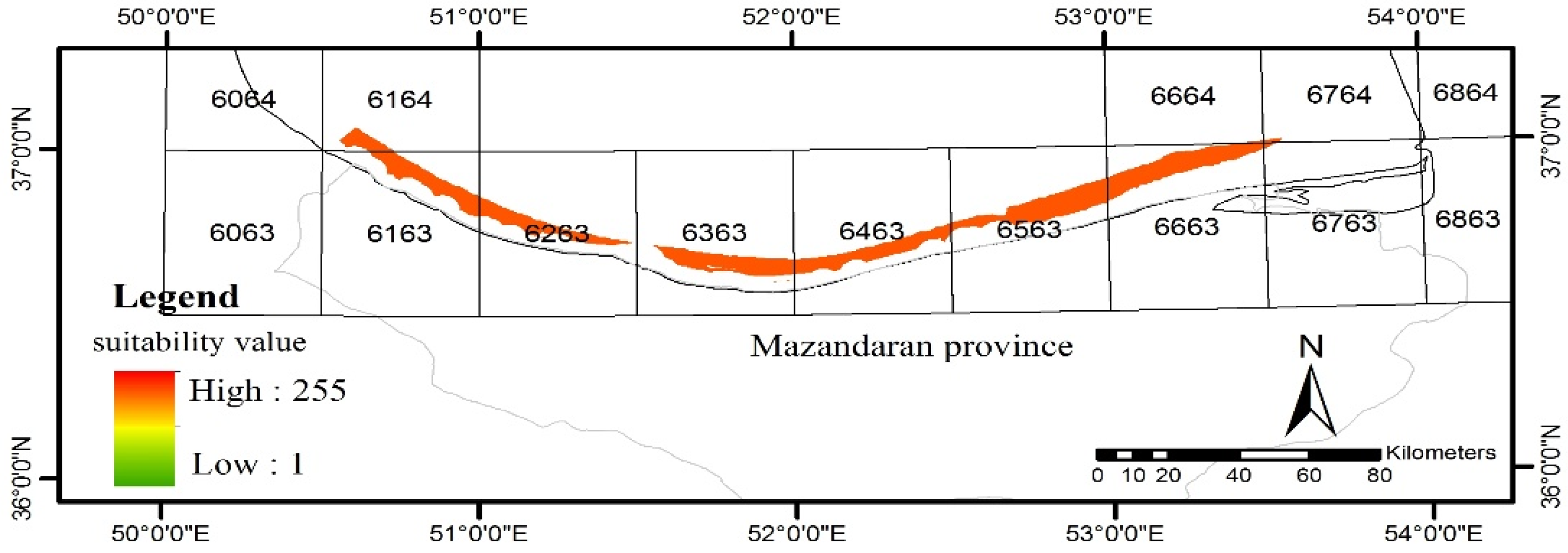
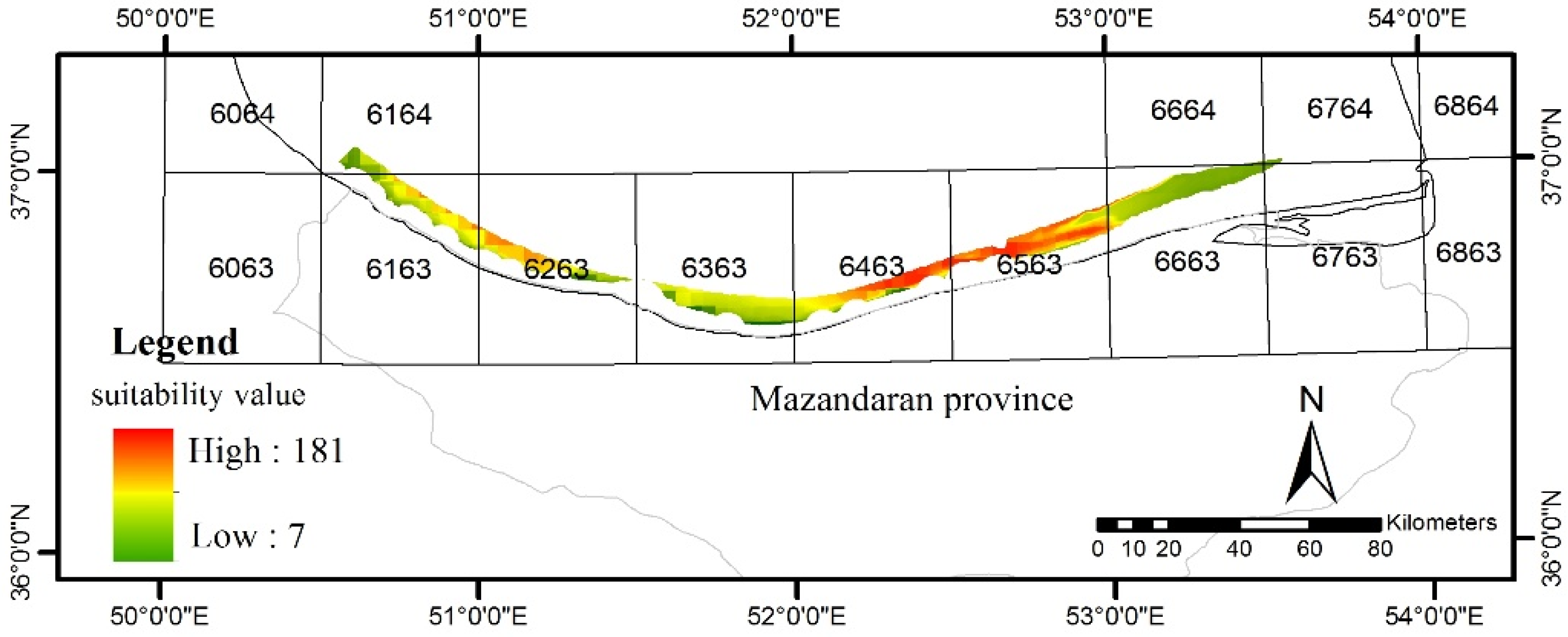
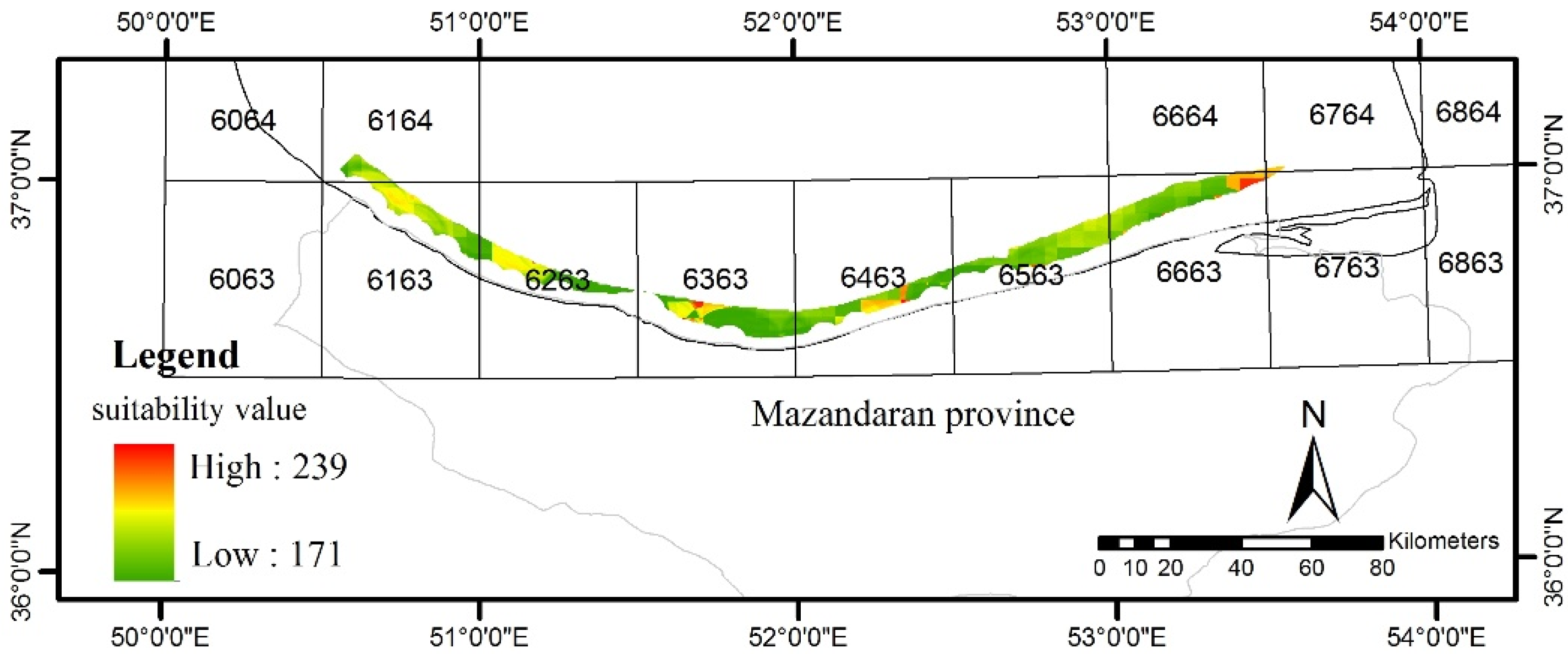
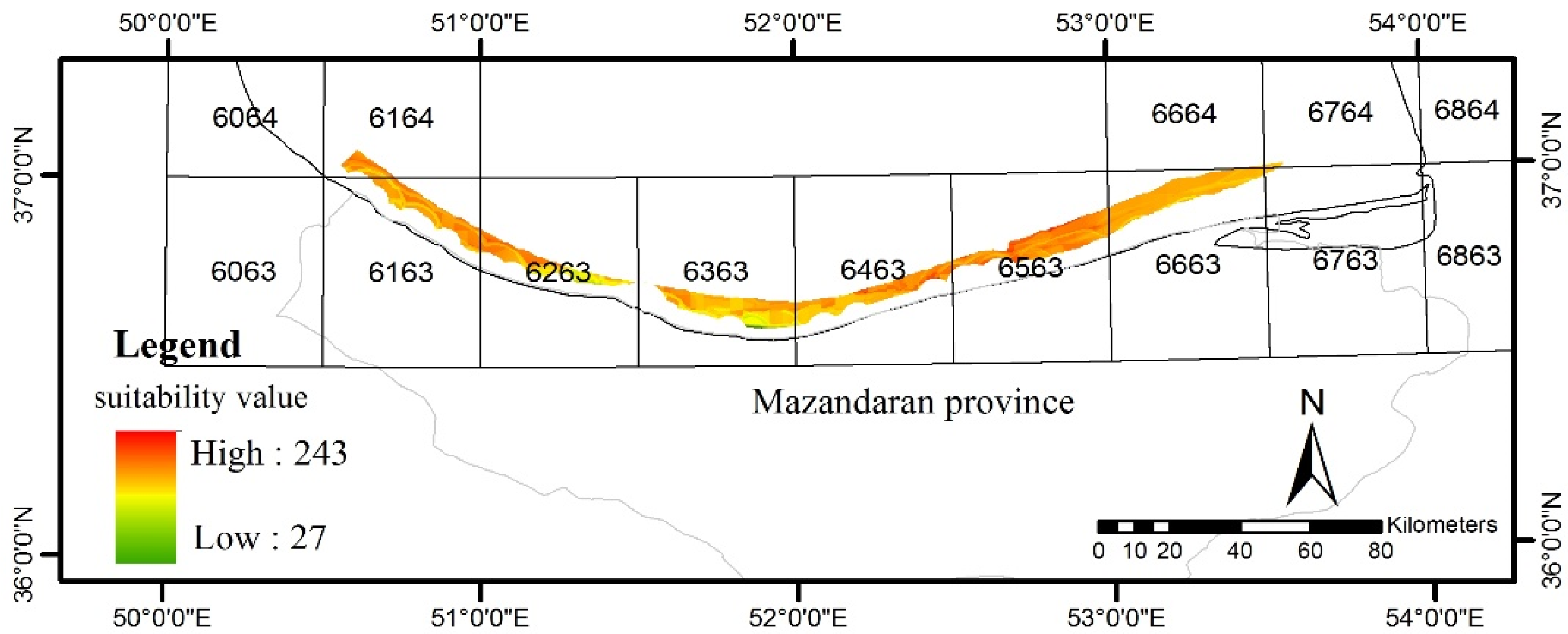
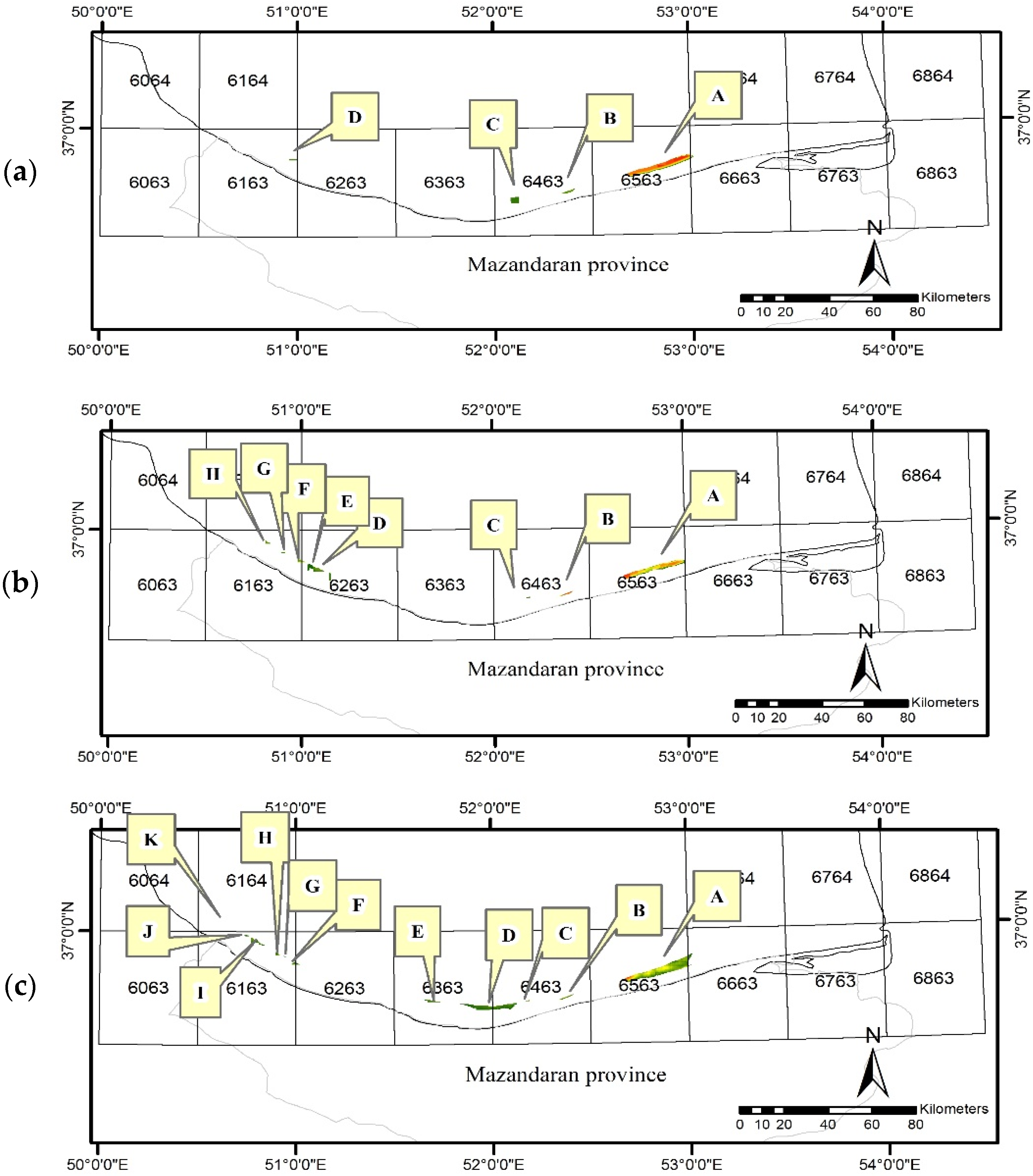
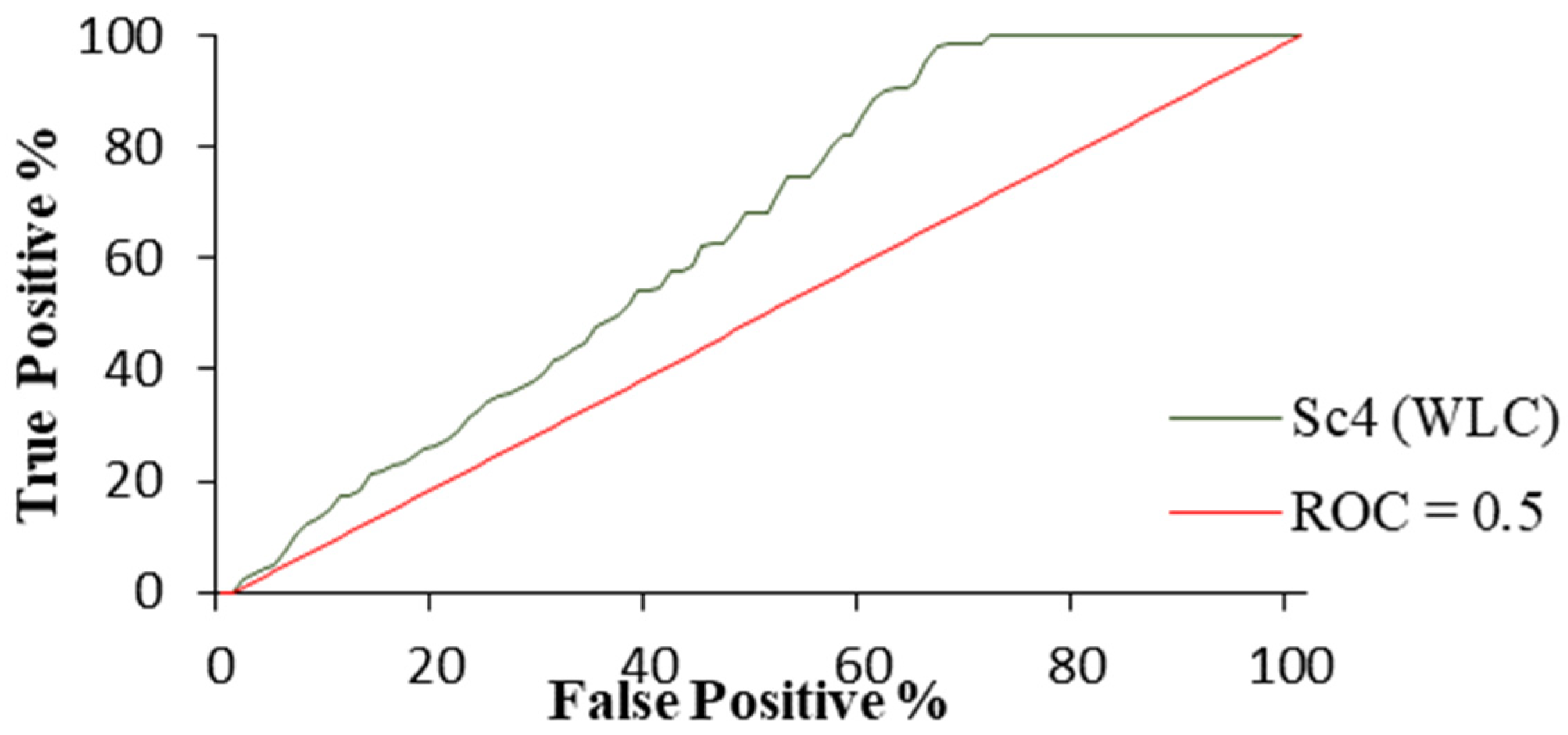
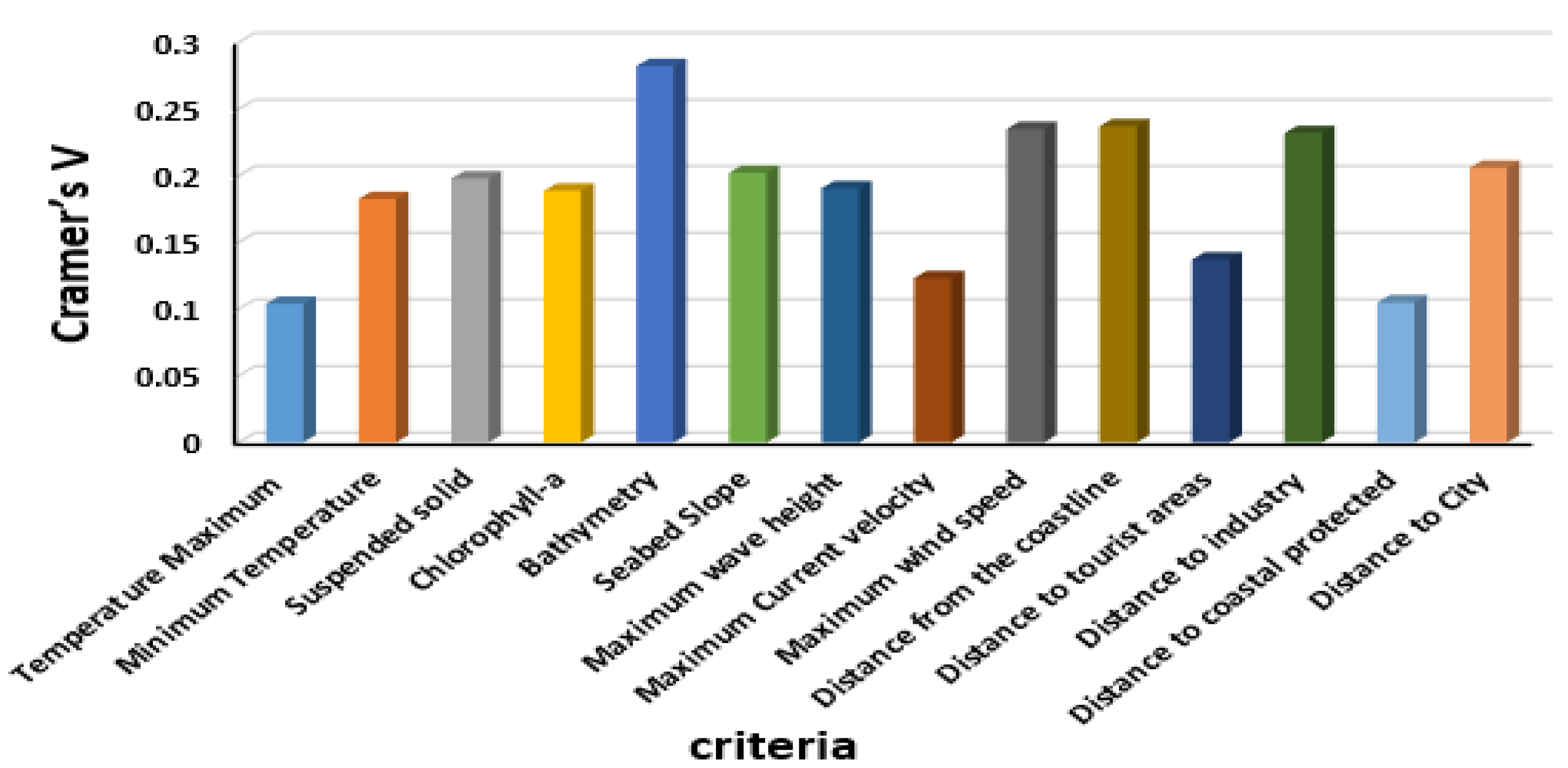
| Sub Models | Criteria | Unit | Scale/Resolution | Sources |
|---|---|---|---|---|
| (Water Quality) | Temperature | °C | 4 km | Moderate Resolution Imaging Spectroradiometer (MODIS) Satellite, Aqua sensor http://oceancolor.gsfc.nasa.gov accessed on 17 February 2021 |
| (Maximum and minimum) | ||||
| Suspended solid | μm−1 Sr−1 | |||
| Chlorophyll-a | Mg/m3 | |||
| (Physical–Environmental) | Bathymetry | M | 1/25,000 | Iran National Cartographic Center |
| Maximum wave height | M | Iran Ports and Maritime Organization (Iranian Seas Wave Modeling ISWM) | ||
| Maximum wind speed | m/s | |||
| Slope Seabed | % | (Depth/distance of the beach) × 100 | ||
| Maximum Current velocity | m/s | 3 km | HYCOM Model, (Kara et al., 2010) | |
| (Social–Economic) | Distance to tourist areas | m | 1/25,000 | Iran National Cartographic Center Iran Department Environmental Iran Ministry of Defence Google Earth 7.1.5.1557 (Gholamalifard et al., 2012) |
| Distance to industry | ||||
| Distance to beach | ||||
| Distance to City | ||||
| Distance to coastal protected areas | ||||
| (Constrain) | Harbor | m | 1/25,000 | |
| The main river mouth | ||||
| Distance from the coastline (3–20 km) | ||||
| Depth (20–50 m) |
| Criteria | Control Points | The Shape and Type of Fuzzy Membership Function | Function Equation | Source | |||
| Maximum Temperature | a | b | c | d | |||
| Liner and Symmetric |  | [32] | |||||
| 20 | 25 | 25 | 30 | ||||
| Minimum Temperature | Liner and Symmetric |  | |||||
| 6 | 10 | 12 | 15 | ||||
| Suspended solid | Liner and Monotonically decreasing |  | [16] | ||||
| 0 | 0 | 0.1 | 3.5 | ||||
| Chlorophyll-a | Sigmoidal and Monotonically decreasing |  | [11] | ||||
| 0 | 0 | 0 | 10 | ||||
| Maximum wave height | Sigmoidal and Monotonically decreasing |  | [32] | ||||
| 0 | 0 | 0 | 4 | ||||
| Maximum wind speed | Sigmoidal and Monotonically decreasing |  | [33] | ||||
| 0 | 0 | 0 | 27 | ||||
| Seabed Slope | Liner and Symmetric |  | [25] | ||||
| 0 | 0.5 | 1 | 10 | ||||
| Maximum Current velocity | Liner and Symmetric |  | [33] | ||||
| 0.02 | 0.15 | 0.2 | 0.3 | ||||
| Bathymetry | Liner and Symmetric |  | |||||
| 0 | 30 | 50 | 100 | ||||
| Distance to industry | Liner and Monotonically increasing |  | |||||
| 0 | 12,000 | 0 | 0 | ||||
| Distance from the coastline | Liner and Symmetric |  | |||||
| 3000 | 5000 | 7500 | 20,000 | ||||
| Distance to City | Liner and Monotonically decreasing |  | |||||
| 0 | 0 | 0 | 4500 | ||||
| Distance to coastal protected | Liner and Monotonically increasing |  | |||||
| 0 | 50,000 | 0 | 0 | ||||
| Distance to tourist areas | Liner and Monotonically increasing |  | |||||
| 0 | 7500 | 0 | 0 | ||||
| (Weight: 0.3808) | ||||||
|---|---|---|---|---|---|---|
| Criteria | (Bath) | (SlS) | (WH) | (CV) | (WS) | Weight Criteria |
| (Bath) 1 | 1 | 0.2575 | ||||
| (SlS) 2 | 2 | 1 | 0.3183 | |||
| (WH) 3 | ½ | 1/2 | 1 | 0.2011 | ||
| (CV) 4 | 1/3 | 1/2 | 1/2 | 1 | 0.0956 | |
| (WS) 5 | 1/3 | ½ | 1/3 | 1/2 | 1 | 0.1275 |
| CR = 0.03 | ||||||
| (Weight: 0.2158) | ||||||
|---|---|---|---|---|---|---|
| Criteria | (DB) | (DP) | (DI) | (DT) | (DC) | Weight Criteria |
| (DB) 1 | 1 | 0.1992 | ||||
| (DI) 1 | ½ | 1 | 0.3195 | |||
| (DT) 1 | ½ | 1 | 1 | 0.2808 | ||
| (DP) 1 | 1/3 | 1/2 | 1/2 | 1 | 0.1365 | |
| (DC) 1 | 1/3 | 1/3 | 1/3 | 1/3 | 1 | 0.0746 |
| CR = 0.02 | ||||||
| (Weight: 0.4034) | |||||
|---|---|---|---|---|---|
| Criteria | (MaxT) | (MaxT) | (SSC) | (Chl-a) | Weight Criteria |
| (MaxT) 1 | 1 | 0.4901 | |||
| (MinT) 2 | 1/3 | 1 | 0.2310 | ||
| (SSC) 3 | 1/3 | 1/2 | 1 | 0.1634 | |
| (Chl-a) 4 | 1/3 | 1/2 | 1/2 | 1 | 0.1155 |
| CR = 0.04 | |||||
| OWA Operator | Owa Weights | Andness | Orness | Trade-Off | |
|---|---|---|---|---|---|
| A | Sc1 (WLC) | [0.071, 0.071, 0.071, … , 0.071, 0.071, 0.071] | 0.5 | 0.5 | 1 |
| B | Sc2 (AND) | [1, 0, 0, 0, 0, … , 0.0, 0, 0] | 1 | 0 | 0 |
| C | Sc3 (OR) | [0, 0, 0, 0, … , 0, 0, 0, 0, 1] | 0 | 1 | 1 |
| D | Sc4 | [0.5, 0.2, 0.1, 0.05, 0.03, 0.02, 0.01…, 0.01, 0.01] | 0.64 | 0.36 | 0.47 |
| E | Sc5 | [0.01, 0.01,…0.01, 0.02, 0.03, 0.05, 0.1, 0.2, 0.5] | 0.36 | 0.64 | 0.47 |
| F | Sc6 (AVG) | [0, 0, … , 0, 0.16, 0.16, 0.16, 0.16,0 …, 0, 0] | 0.55 | 0.44 | 0.62 |
| Parameters | MaxT | MinT | Bath | SSC | Chl-a | WH | WS | SlS | CV | DI | DT | DC | DB | DP | |
|---|---|---|---|---|---|---|---|---|---|---|---|---|---|---|---|
| Farm 1 | Parameter value | 256 | 20 | 0.50 | 2.7 | 5.9–6.4 | 18.5 | 0.3 | 0.1 | 4.3 | 10.0 | 11.6 | 5.2 | 35.1 | 9.4 |
| Fuzzy number | 151 | 97 | 172 | 186 | 140 | 190 | 221 | 163 | 110 | 255 | 189 | 241 | 203 | 200 | |
| Farm 2 | Parameter value | 27.1 | 28 | 0.47 | 2.9 | 5.9–6.4 | 20.1 | 0.5 | 0.11 | 2.9 | 3.8 | 2.5 | 5.5 | 60.6 | 8.3 |
| Fuzzy number | 15 | 230 | 180 | 179 | 140 | 130 | 238 | 188 | 74 | 122 | 240 | 250 | 255 | 161 | |
| Farm 3 | Parameter value | 27.0 | 31 | 0.68 | 0.3 | 2.6 | 19.2 | 0.4 | 0.06 | 6.1 | 3.8 | 13.4 | 6.4 | 7.0 | 7.6 |
| Fuzzy number | 165 | 248 | 116 | 176 | 230 | 185 | 246 | 85 | 156 | 123 | 178 | 246 | 12 | 95 | |
| Farm 4 | Parameter value | 27.2 | 44 | 0.56 | 2.7 | 4.8–3.2 | 19.2 | 0.8 | 0.07 | 5.5 | 3.3 | 2.9 | 5.5 | 6.6 | 7.7 |
| Fuzzy number | 148 | 255 | 161 | 185 | 190 | 185 | 166 | 111 | 141 | 105 | 238 | 250 | 10 | 101 | |
| Farm 5 | Parameter value | 26.1 | 28 | 0.71 | 2.9 | 5.9–6.4 | 19.6 | 0.8 | 0.07 | 1.6 | 1.0 | 0.6 | 3.2 | 14.5 | 7.5 |
| Fuzzy number | 192 | 201 | 109 | 181 | 140 | 150 | 155 | 112 | 42 | 32 | 252 | 55 | 49 | 86 | |
| Farm 6 | Parameter value | 27.2 | 26 | 0.69 | 2.7 | 5.9–6.4 | 20.1 | 0.7 | 0.07 | 3.1 | 4.9 | 0.8 | 3.6 | 19.4 | 7.2 |
| Fuzzy number | 115 | 190 | 114 | 184 | 140 | 130 | 186 | 103 | 79 | 156 | 251 | 92 | 83 | 84 | |
| Farm 7 | Parameter value | 27.2 | 29 | 0.78 | 2.9 | 5.9–6.4 | 20.1 | 0.5 | 0.09 | 3.1 | 17.2 | 1.9 | 5.1 | 31.8 | 7.4 |
| Fuzzy number | 146 | 232 | 87 | 180 | 140 | 130 | 223 | 139 | 80 | 255 | 243 | 282 | 180 | 71 | |
| Farm 8 | Parameter value | 27.0 | 31 | 0.97 | 2.9 | 5.9–6.4 | 20.1 | 0.5 | 0.09 | 3.4 | 14.0 | 3.3 | 5.8 | 44.5 | 7.8 |
| Fuzzy number | 166 | 253 | 38 | 180 | 140 | 130 | 233 | 151 | 87 | 255 | 232 | 252 | 24 | 112 | |
| Farm 9 | Parameter value | 26.6 | 21 | 0.53 | 3.0 | 5.5 | 18.5 | 0.6 | 0.07 | 0.9 | 0.5 | 0.5 | 3.1 | 75.1 | 6.7 |
| Fuzzy number | 190 | 113 | 158 | 177 | 160 | 190 | 196 | 113 | 23 | 17 | 252 | 32 | 255 | 74 | |
| Sites | Parameters | MaxT | MinT | Bath | SSC | Chl-a | WH | WS | SlS | CV | DI | DT | DC | DB | DP |
|---|---|---|---|---|---|---|---|---|---|---|---|---|---|---|---|
| A | Parameter value | 26.7 | 7.3 | 48.5 | 0.9 | 2.6 | 5.4 | 18.2 | 0.48 | 0.08 | 11.2 | 9.0 | 10.6 | 9.9 | 66.4 |
| Fuzzy number | 182 | 111 | 255 | 34 | 188 | 160 | 190 | 246 | 132 | 255 | 255 | 194 | 184 | 255 | |
| B | Parameter value | 26.4 | 7.4 | 48.8 | 0.7 | 2.8 | 5.6 | 18.4 | 0.52 | 0.07 | 7.1 | 6.3 | 6.0 | 9.2 | 69.6 |
| Fuzzy number | 208 | 127 | 254 | 91 | 183 | 160 | 190 | 235 | 111 | 183 | 201 | 220 | 195 | 255 | |
| C | Parameter value | 26.4 | 7.4 | 46.3 | 0.8 | 2.9 | 5.7 | 18.6 | 0.52 | 0.09 | 6.2 | 7.3 | 5.9 | 8.9 | 65.2 |
| Fuzzy number | 205 | 125 | 254 | 76 | 180 | 160 | 190 | 237 | 149 | 160 | 232 | 221 | 202 | 255 | |
| D | Parameter value | 26.6 | 7.7 | 49.0 | 0.6 | 2.8 | 5.9 | 18.8 | 0.57 | 0.08 | 6.2 | 8.6 | 5.3 | 8.5 | 53.5 |
| Fuzzy number | 125 | 134 | 254 | 112 | 183 | 160 | 190 | 224 | 131 | 158 | 254 | 224 | 209 | 255 | |
| E | Parameter value | 26.7 | 7.5 | 49.8 | 0.8 | 2.8 | 5.9 | 19 | 0.53 | 0.09 | 7.0 | 11.5 | 6.2 | 9.3 | 50.0 |
| Fuzzy number | 184 | 128 | 254 | 82 | 182 | 140 | 190 | 234 | 149 | 180 | 255 | 119 | 194 | 255 | |
| F | Parameter value | 27.0 | 7.8 | 47.9 | 0.6 | 2.8 | 6.1 | 19.2 | 0.51 | 0.09 | 6.8 | 15.9 | 6.7 | 9.3 | 44.2 |
| Fuzzy number | 166 | 143 | 254 | 128 | 182 | 140 | 190 | 239 | 138 | 175 | 255 | 216 | 193 | 246 | |
| G | Parameter value | 26.8 | 9.8 | 26.1 | 0.4 | 2.7 | 6.2 | 19.6 | 0.37 | 0.09 | 5.5 | 8.9 | 11.1 | 7.0 | 43.4 |
| Fuzzy number | 177 | 253 | 188 | 175 | 183 | 140 | 150 | 177 | 142 | 140 | 224 | 191 | 233 | 231 | |
| H | Parameter value | 57.0 | 7.9 | 28.9 | 0.4 | 2.8 | 6.3 | 19.8 | 0.70 | 0.1 | 7.6 | 11.1 | 3.2 | 4.0 | 40.0 |
| Fuzzy number | 160 | 179 | 236 | 188 | 180 | 140 | 150 | 192 | 172 | 195 | 255 | 236 | 139 | 230 | |
| I | Parameter value | 27.0 | 7.7 | 49.6 | 0.4 | 3.0 | 6.4 | 20 | 0.64 | 0.14 | 23.5 | 5.5 | 4.7 | 7.7 | 24.0 |
| Fuzzy number | 166 | 157 | 254 | 186 | 177 | 140 | 150 | 208 | 241 | 255 | 175 | 228 | 223 | 119 | |
| J | Parameter value | 27.1 | 7.6 | 49.2 | 0.4 | 2.9 | 4.8–5.4 | 19.6 | 0.47 | 0.09 | 10.4 | 9.6 | 9.8 | 10.0 | 10.8 |
| Fuzzy number | 156 | 152 | 254 | 173 | 179 | 165 | 170 | 248 | 151 | 249 | 255 | 199 | 176 | 28 | |
| K | Parameter value | 26.8 | 7.7 | 47.1 | 0.5 | 3.1 | 1.8–3.7 | 19.2 | 0.52 | 0.08 | 10.0 | 7.3 | 6.2 | 9.1 | 12.2 |
| Fuzzy number | 180 | 160 | 254 | 166 | 174 | 210 | 185 | 236 | 122 | 233 | 218 | 219 | 198 | 36 |
| Sub Models | Scenario | Interval Values | Difference Image | Percentage Change | Ratio Images |
|---|---|---|---|---|---|
| Water Quality | 1 | +20 | 1.9 | 1.12 | 0.98 |
| 2 | +10 | 1.06 | 0.65 | 0.99 | |
| 3 | +5 | 0.56 | 0.33 | 0.99 | |
| 4 | –5 | 0.64 | 0.17 | 1.003 | |
| 5 | −10 | 1.37 | 0.76 | 1.008 | |
| 6 | −20 | 3.01 | 1.67 | 1.01 | |
| Physical–Environmental | 7 | +20 | 0.94 | 0.5 | 1.006 |
| 8 | +10 | 0.52 | 0.30 | 1.003 | |
| 9 | +5 | 0.27 | 0.17 | 1.001 | |
| 10 | −5 | 0.31 | 0.21 | 0.99 | |
| 11 | −10 | 0.69 | 0.5 | 0.99 | |
| 12 | −20 | 1.38 | 1.5 | 0.98 | |
| Social–Economic | 13 | +20 | 2.23 | 1.28 | 1.01 |
| 14 | +10 | 1.28 | 0.67 | 1.006 | |
| 15 | +5 | 0.67 | 0.35 | 1.003 | |
| 16 | −5 | 0.81 | 0.45 | 0.99 | |
| 17 | −10 | 1.71 | 0.97 | 0.99 | |
| 18 | −20 | 3.05 | 1.77 | 0.98 |
Publisher’s Note: MDPI stays neutral with regard to jurisdictional claims in published maps and institutional affiliations. |
© 2021 by the authors. Licensee MDPI, Basel, Switzerland. This article is an open access article distributed under the terms and conditions of the Creative Commons Attribution (CC BY) license (http://creativecommons.org/licenses/by/4.0/).
Share and Cite
Haghshenas, E.; Gholamalifard, M.; Mahmoudi, N.; Kutser, T. Developing a GIS-Based Decision Rule for Sustainable Marine Aquaculture Site Selection: An Application of the Ordered Weighted Average Procedure. Sustainability 2021, 13, 2672. https://doi.org/10.3390/su13052672
Haghshenas E, Gholamalifard M, Mahmoudi N, Kutser T. Developing a GIS-Based Decision Rule for Sustainable Marine Aquaculture Site Selection: An Application of the Ordered Weighted Average Procedure. Sustainability. 2021; 13(5):2672. https://doi.org/10.3390/su13052672
Chicago/Turabian StyleHaghshenas, Elham, Mehdi Gholamalifard, Nemat Mahmoudi, and Tiit Kutser. 2021. "Developing a GIS-Based Decision Rule for Sustainable Marine Aquaculture Site Selection: An Application of the Ordered Weighted Average Procedure" Sustainability 13, no. 5: 2672. https://doi.org/10.3390/su13052672
APA StyleHaghshenas, E., Gholamalifard, M., Mahmoudi, N., & Kutser, T. (2021). Developing a GIS-Based Decision Rule for Sustainable Marine Aquaculture Site Selection: An Application of the Ordered Weighted Average Procedure. Sustainability, 13(5), 2672. https://doi.org/10.3390/su13052672






